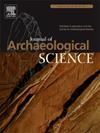从考古亚麻布中提取有机香膏的多功能综合方案:为受污染纺织品提供可靠放射性碳年代测定的新方法
IF 2.6
1区 地球科学
Q1 ANTHROPOLOGY
引用次数: 0
摘要
当外源性有机香脂沉积在考古纺织品表面时,放射性碳测年尤其具有挑战性,因为这些有机混合物有时可能含有放射性碳耗尽的物质,如沥青化石。这是对用于包裹埃及木乃伊的亚麻碎片进行放射性碳定年的一个关键问题,因为沥青已经在几个环境中被反复识别出来。使用ATR-IR(衰减全反射-红外光谱)对纺织品表面进行分析,以诊断每个碎片上观察到的污染状态,然后进行三步有机提取,以去除已确定的所有化学家族,从而促进了污染碎片的放射性碳定年。本研究分为两部分。首先,用现代亚麻和实验香脂制作的模型样品,以开发一种基于ATR-IR诊断纺织品污染状态的综合方法,然后采用溶剂萃取法去除有机污染物。采用ATR-IR和放射性碳定年法对溶剂萃取过程进行监测,以控制化石化合物的完全去除。所选择的提取方案是一个三步程序(3x CHCl3,然后3x己烷,然后3x MeOH),可以根据纺织品上有机污染的状态和性质进行调整。这种新的综合方法可以以多种方式使用,以确保亚麻考古纺织品的可靠放射性碳定年,然后将其应用于从保存在mussame des Confluences的埃及儿童木乃伊中收集的样本,该木乃伊使用包括使用化石沥青的过程进行防腐处理。多亏了这项新技术,我们得以将这具木乃伊的年代确定为埃及晚期。本文章由计算机程序翻译,如有差异,请以英文原文为准。
A versatile integrated protocol to extract organic balms from archaeological linen: A new way to provide reliable radiocarbon dating for contaminated textile
Radiocarbon dating of archaeological textiles can be particularly challenging when exogenous organic balms were deposited on their surface, as these organic mixtures can sometimes contain radiocarbon-depleted materials such as fossil bitumen. This is a key issue for radiocarbon dating of linen fragments used in the wrapping of Egyptian mummies, as bitumen has been repeatedly identified in several contexts. Radiocarbon dating of contaminated fragments can be facilitated by an analytical approach involving textile surface analysis by ATR-IR (Attenuated Total Reflection – Infrared Spectroscopy) to diagnose the state of contamination observed on each fragment, followed by a three-step organic extraction to remove all chemical families identified. This study was organized in two parts. First, mock-up samples were prepared, made of modern linen and experimental balms, to develop an integrated methodology based first on ATR-IR diagnosis for the state of contamination of textile, then on a solvent extraction to remove organic contaminants. The solvent extraction was monitored by ATR-IR and radiocarbon dating to control the complete removal of fossil compounds. The extraction protocol chosen is a three-step procedure (3x CHCl3, then 3x hexane, then 3x MeOH), which can be tunable depending on the state and the nature of organic contamination on the textile. This new integrated methodology, which can be used in a versatile way to ensure reliable radiocarbon dating of linen archaeological textiles, was then applied to samples collected from an Egyptian child mummy conserved in Musée des Confluences, embalmed using a process that included the use of fossil bitumen. Thanks to this new protocol, we were able to date this mummy to the Late Period of Egypt.
求助全文
通过发布文献求助,成功后即可免费获取论文全文。
去求助
来源期刊

Journal of Archaeological Science
地学-地球科学综合
CiteScore
6.10
自引率
7.10%
发文量
112
审稿时长
49 days
期刊介绍:
The Journal of Archaeological Science is aimed at archaeologists and scientists with particular interests in advancing the development and application of scientific techniques and methodologies to all areas of archaeology. This established monthly journal publishes focus articles, original research papers and major review articles, of wide archaeological significance. The journal provides an international forum for archaeologists and scientists from widely different scientific backgrounds who share a common interest in developing and applying scientific methods to inform major debates through improving the quality and reliability of scientific information derived from archaeological research.
 求助内容:
求助内容: 应助结果提醒方式:
应助结果提醒方式:


